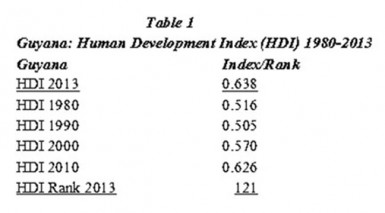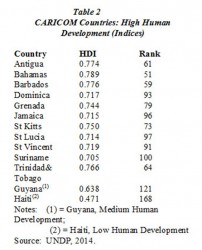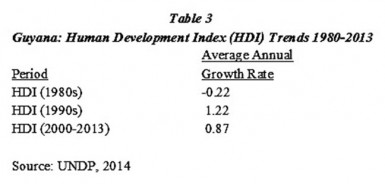The class of United Nations Development Programme (UNDP) human development indicators is an intellectual derivate of the deprivation of basic needs approach, to poverty assessment discussed last week. It was first introduced in 1990 in the form of the Human Development Index (HDI).
This indicator has been subjected to several rich innovations, permutations and other additions since then. These include the production of the Gender Inequality Index (GII), which adjusts the HDI for gender inequities; the Multidimensional Poverty Index (MPI), which adjusts the HDI for multiple factors bearing on poverty, especially those that are not linked to income and consumption, and the Inequality-adjusted Human Development Index, IHDI.
For the purposes of this week’s column the most important innovation has been the introduction of the Inequality-adjusted Human Development Index (IHDI). The UNDP has calculated this index for Guyana starting in 2010 and it is available along with its ongoing HDI series, which will be considered in some detail in today’s column.
Worldwide, the UNDP’S, HDI is undoubtedly the most celebrated human development indicator.
It is calculated as a single number representing a national average of human development for Guyana. It should be noted immediately though that, like all averages, while it succinctly indicates the value of what is being measured, it also conceals the distribution surrounding that average value among the measured population. The HDI measures three combined dimensions or components of human development in Guyana. These are 1) the ability of Guyanese to live long and healthy lives; 2) knowledge (education); and 3) the population’s ability to command a decent standard of living. These three dimensions are estimated respectively by 1) the country’s average life expectancy at birth; 2) an education index, which measures the average years of schooling of a person 25 years and over plus the number of expected years a five year old Guyanese is likely to spend on education throughout his or her whole life; and 3) gross national income at purchasing power parity in US dollars per person.
Table 1 below shows Guyana’s latest HDI and comparisons with 1980, 1990, 2000 and 2010.
Source: UNDP, 2014
Guyana’s HDI, which was at 0.638 in 2013 (and ranked 121), was the lowest in the Caricom region, except for Haiti. Significantly, the UNDP has created four levels of human development or categories of countries worldwide based on its HDI estimates. These are those with1) a very high level of human development; 2) a high level of human development; 3) a medium level of human development; and 4) a low level of human development. All the Caricom countries, except Guyana and Haiti are classed at level 2.However, Guyana is classed at level 3 and Haiti at level 4.
These regional data are shown in Table 2. Of special note readers should be aware that Cuba with an HDI of 0.815 and a rank of global of 44 out of 187 countries is classed at level 1 (very high human development)!
It would be useful if readers also observed the trends in Guyana’s HDI performance, which are revealed in Table 3. During the 1980s the growth rate for the HDI was negative (-0.22 per cent). In the 1990s it grew by 1.22 per cent, declining to 0.87 per cent for the period 2000-2013.
Inequality-adjusted Human Development Index (IHDI)
The IHDI was introduced in 2010 as a new measure of the level of human development in society that explicitly takes into account inequalities in the three dimensions captured in the HDI. Like the HDI the focus is to establish a measure that allows for international comparisons among countries. Thus the HDI reports on 187 countries but the IHDI reports on 145 countries because of data constraints.
The UNDP however encourages national adaptation of both its HDI and IHDI approaches to benchmarking development. The former has been done for Guyana.
Simply put, according to the UNDP, the HDI seeks to establish the potential of a country for human development.
And, the IHDI reduces this potential if there are inequalities in any of the three dimensions used to calculate the HDI.
Therefore, if there are no inequalities both the HDI and the IHDI would have the same value! Consequently, the differences between the two indexes measure the “loss” imposed on development by inequality. Table 4 shows the UNDP value of the two indexes for Guyana in 2013.
The loss in human development for Guyana is given as 18.2 per cent, which is substantial, but below the world average of 22.9 per cent. In order to measure the extent of inequality the UNDP has employed a number of ingenious techniques.
Thus for example inequalities in a long and healthy life for Guyanese have been derived from census estimates of life expectancy for different groups and areas where the population resides. Similarly, estimates of standard of living for population groups have been obtained from surveys like the HIES, which was considered at length earlier. Such surveys also yield information on education and years of schooling.











